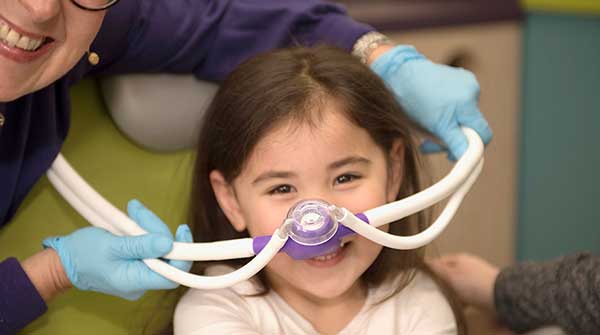Inhaled nitrous oxide is safe and effective and could help prevent lifelong issues like needle phobia
Inhaled nitrous oxide, commonly known as laughing gas, should be more widely utilized in managing pain and distress in children undergoing emergency treatment in hospitals, according to a University of Alberta expert.

Samina Ali
Professor Samina Ali, a pediatric emergency physician at the Stollery Children’s Hospital and professor of pediatrics and emergency medicine in the Faculty of Medicine & Dentistry, emphasizes the importance of improving the pain experience for children in emergency departments. “The more we can do for children to improve their pain experience in the emergency department – which is often their first exposure to health care in a crisis – the better they will cope as older children on repeat visits and as adults,” she says.
While nitrous oxide is used extensively in dental offices, labour and delivery in hospitals, and by paramedics, its application in pediatric emergency departments in Canada remains limited. This limitation has led to unnecessary pain in many children and sometimes contributed to needle phobia issues.
Ali and her colleagues recently published a review of Canadian clinical trials that investigated the use of nitrous oxide for pain management in pediatric emergency centres.
Their research review, led by Naveen Poonai and published in the Canadian Journal of Emergency Medicine, is part of a series of studies aiming to gather evidence for the safe use of nitrous oxide in pediatric pain management in Canada. Ali highlights that six out of 10 children arrive in pediatric emergency departments with painful conditions, making effective pain management a significant challenge.
The recent study examined 30 clinical trials where inhaled nitrous oxide was used, primarily during IV insertion or laceration repair using stitches. The evidence from these trials indicates that nitrous oxide is safe and effective during IV insertion, particularly when combined with numbing creams. It is also a viable option for laceration repair, although further research is planned in this regard.
“By using nitrous oxide, which doesn’t involve a needle and doesn’t involve having to swallow a medication – both of which can be tremendously challenging for children – we’re able to manage their pain in a way that’s less invasive and contributes to less stress for them,” Ali says.
Effective pediatric pain management in emergency departments goes beyond providing comfort for children and alleviating their families’ stress. Needle phobia, affecting up to one in 10 adults, often begins in childhood and can have serious implications for healthcare. “Needle phobia can prevent people from getting immunized or seeking treatment for infectious diseases. We’ve seen the results of needle phobia with COVID. When we asked adults, ‘Why aren’t you getting your vaccines?’ a good number of them said it was because they didn’t like needles,” Ali says.
Treating a child’s pain with nitrous oxide during certain painful procedures benefits patients, healthcare providers, and hospital administrators alike. It is effective, safe, cost-effective, readily available, and easy to administer through an on-demand mouthpiece or continuous-flow mask for the youngest patients.
However, a recent survey by Pediatric Emergency Research Canada (PERC) researchers reveals that less than half of Canadian pediatric emergency physicians use nitrous oxide for pain and distress management in the emergency department, mainly due to its unavailability at their sites. A forthcoming study to be published this fall also shows that nitrous oxide was used in only six out of 15 Canadian pediatric emergency hospitals in 2021.
Ali remains hopeful that as their research gains wider recognition, the number of hospitals utilizing nitrous oxide for pediatric pain management will increase and reach double digits within the next five years. She emphasizes the importance of sharing knowledge with families to empower them to advocate using nitrous oxide to manage their child’s pain and anxiety.
| Troy Media
For interview requests, click here.
The opinions expressed by our columnists and contributors are theirs alone and do not inherently or expressly reflect the views of our publication.
© Troy Media
Troy Media is an editorial content provider to media outlets and its own hosted community news outlets across Canada.


